More practical tips for small animal practice
Following on her article in the January edition of Veterinary Ireland Journal earlier this year, Dr Aine Seavers MVB MRCVS shares some more practical tips derived from her own experience in small animal practice. In this article, she looks at how to sensitively help owners face the euthanasia of a pet, the practical realities of storage of bodies of deceased dogs, and the importance of the correct choice of litter box to ensure comfortable and healthy feline urination
Euthanasia: knowing when it’s time
Euthanasia is the gift of a peaceful death, gifted by a loving owner to allow their pet to be finally free from physical, or mental, or emotional pain and suffering.
Clients the world over ask us as their vet: “How will we know when it’s time to stop?” Vets invariably and correctly reply: “You will know.”
However, there is an awful lot of worrying and concern until that moment of clarity and knowing is reached. Many owners would like to have more warning of the sort of things they need to be alert to when caring for a terminal or very elderly pet. We found having a short quality-of-life questionnaire to share in a consultation with clients helped them prepare by giving them a physical checklist as a framework to enable them to enjoy the final months of their pet’s life with less worry about the unknown (see Table 1).

Table 1. A typical quality of life (QOL) checklist.
The University of Ohio has a free in-depth questionnaire owners can access for more guidance on this topic: https://vet.osu.edu/.../HonoringtheBond/HowDoIKnowWhen.pdf
We also pre-warn the client that while euthanasia ends the suffering of their pet, in doing so the client may experience the intense grief of losing a best friend, a family member, etc. With that grief, comes a world of pain and hence the huge conflict owners often feel after the euthanasia. It’s important to alert the client in advance that it’s okay to feel down, that there is no shame whatsoever in feeling the loss so intensely. Whenever the decision is made to let a pet go, even if it’s made with so much love, it is meant to be a difficult process.
The most important thing to remember is that all animals have the right to pass. It is unthinkable to allow an animal that has been loved and cherished all its life to suffer so much at the end that it deteriorates into an animal that is not a true version of how it thrived through its life.
Wrapping the bodies of deceased dogs
A disproportionate number of injuries to staff occur when moving the bodies of deceased dogs, especially when rigor mortis has set in on a body contained in a body bag. The resultant awkwardly-shaped large bag and its contents can be nigh impossible for vet staff to grip and carry.
So, here are some of the tips I have heard of, or devised along the way, that can help make for safer workplaces by reducing the eventual size and awkwardness in handling of the frozen or rigor body.
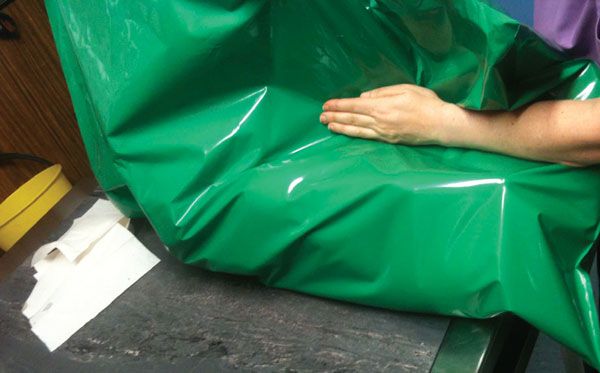
Figure 1.
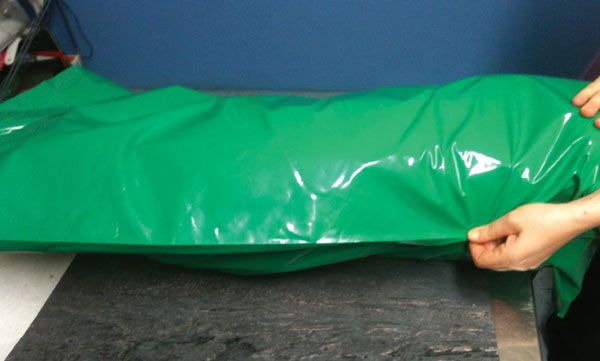
Figure 2.
Using a plastic body-bag for burial
First, slip the body into the bag. Then, either tilt the bag and body onto one side or position the dog on its back in the bag. Then fold the limbs, tuck in the head, and very quickly, fold or wrap the bag tightly over the folded body. Secure tightly in place with cell tape or string. The result is a smooth, cylindrical shape that is much easier to be carried by more than one person (see Figures 1,2, and 3).
When the wrapped body then tries to expand in rigor mortis or freezing, the limbs can’t jut out and hence get jammed into the sides of the freezer making removal more difficult or distressing. The long rectangular shape also increases the storage capacity of the freezer as it reduces the body’s surface area.
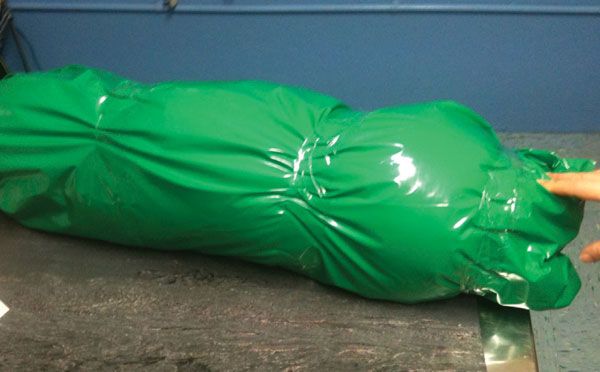
Figure 3.
We wrapped all our bodies like this, even the small cats and rabbits as it reduced the amount of storage space taken up by all the deceased bodies in the freezer (see Figure 4).
The tubular sleeping form also makes for a less disturbing visual if the owner changes their mind and decides to come back and bring the body for a home burial. If the body bag wrap may be an upsetting visual to the owner, just remove the plastic bag from the body to wrap the pet in sheets or towels for the owner to collect.
Crematorium companies have reported back that bodies wrapped in this way also fit much more easily into crematorium ovens, which tend to be narrow.
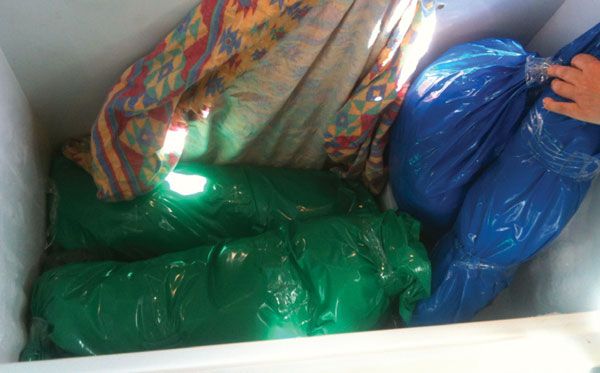
Figure 4.
Additional tips
By taking the very end sections, top and bottom, of the bag/sheet, twisting them into a small knot, and then wrapping cellophane around the ends, you create ‘handles’ that makes the body easier to be held, lifted, and carried. Do not use cable ties on these bags if the body has to be stored chilled or frozen. The cable ties perish and snap leaving sharp edges that lacerate the staff’s hands when picking up the ends.
Another option is to lay the wrapped larger bodies on top of a loose, large sheet laid down in the freezer. Then, when you need to lift a big body from the depth of the freezer, you have, in effect, a sling stretcher or fulcrum that allows several people to get hold of the sheet to pull the body up. This sling allows the humans doing the removal to remain in a more upright position rather than be half-hanging into the sides of the freezer.
If not using a body bag
Position the larger dogs on their sides and flex and tuck the limbs in tight to the body. Taking wide clear packing tape, wrap up and over the body from the planter/palmer aspect of the limbs to strap the limbs in position against the body.
If the owner is taking the body home, wrap a sheet or shroud tightly around this taped tubular form, but leave the sheet loosely draped over the head so the owner can still see their pet’s face if they wish.
One can reverse the sequence and tightly wrap first in the sheet, and then apply the tape or the strapping. For giant breed dogs, I also tuck the neck between the front legs to reduce the overall length.
Cat urination outside the litter box
It is a given that there are many medical, dietary, behavioural, and environmental issues as to why any cat may exhibit signs of cystitis, perichezia, periuria, or behavioural spraying, etc. As vets, we are capable of tracking down the various dietary/microbes/pudendal neuritis/ulcers/stress/calculi/diabetic players and addressing those primary disease expression players.
However, there is a general background level of dissonance with both owners and vets regarding the absolute need to provide access to a urination zone that allows cats to fully express appropriate voiding behaviour. One of the major ways we fail our cat is in what we have designated as a litter tray or toilet box. Traditionally, we humans have only looked at the form, not the function, of these trays.
This can result in the owner using small supermarket-purchased litter trays that fit neatly into the home décor and/or placing the trays in sites that suit the owner. Another mistake is expecting all cats to use the one box, regardless of the size and age of the cat or cats.
This complete dissonance, as to what the cat wants, as opposed to what we humans provide them with, is probably one of the leading causes of cat rehoming or euthanasia.
Litter tray size
A litter tray should be at least 1.5 times the length of the cat. That is the minimum size. We could, and indeed should, easily provide much longer trays, yet most trays I see sold in supermarkets, etc. are simply far too small a size for all bar a kitten.
As a result of this tiny size and accompanying shallow litter depth, the cat can’t express proper pre-urination scratching behaviours, i.e., a deep scratch, sniff, and a further scratch.
To make matters worse, the cat then has to position itself into a tucked-up, unnatural squatting position in order to urinate. As a result, the bladder may not fully empty each time thus setting the cat up for bladder-related problems further down the line.
Lids
In relation to whether or not to cover the tray, the answer may well depend on gender and/or age. While commercially-covered litter boxes tend to be larger in length, these boxes are not wide enough. In these instances, there is not enough room for cats to turn around without bending or twisting (Figure 5).
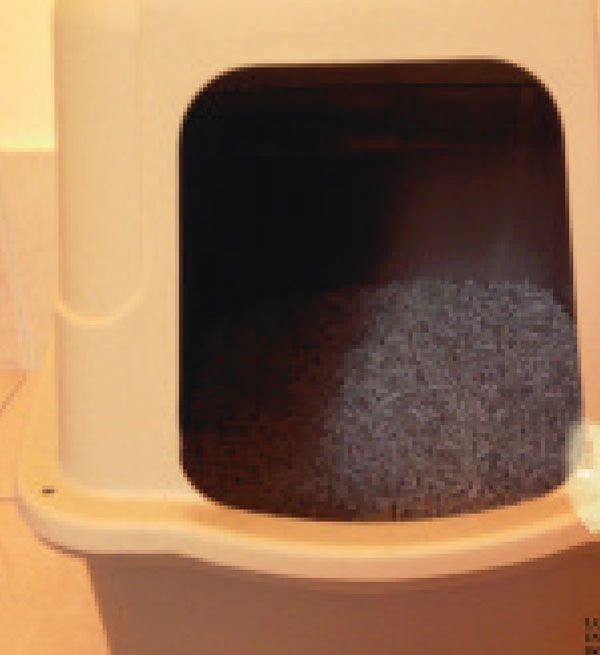
Figure 5.
Many older cats have undetected arthritis; they avoid bending and twisting so, as they age, often they walk halfway inside the box, stop there, don’t turn around, and then spray urine in an arc out onto the floor. (In the case of a Siamese, often up to a metre away!) The owner finds the mess, presumes there is a loss of toilet training skills in old age, and puts it down to dementia or arthritis. Yet the cat doesn’t need medication, all it needs is an age-appropriate litter box.
Many male cats like to arch up as they urinate. In this case, they hit their heads on the roof of the very covered litter trays we were advised to use in order to give the nervous cat more security while urinating. Instead, the cover can make such a cat paranoid about using its litter tray.
Behaviourist specialists suggest that the flap on a litter tray entrance may also be one step too many for a cat with bladder issues. Tall cats (especially Siamese) generally hate these flaps which sit on their heads or flip down and trap them in their urination fumes, so they will attempt to avoid using those fully enclosed litter boxes at all cost.
Litter tray solutions
a) Length
Extra-large, commercially-covered litter boxes may resolve some of the issues but at €200 each, are often too expensive for many. What is affordable are those long shallow under-bed €10 plastic tubs (see Figure 6) found in any clearance/hardware stores etc. These tubs can then be deeply filled with the cat’s choice of litter substrate.
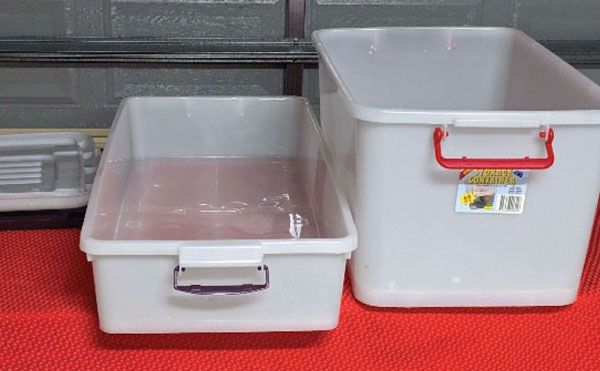
Figure 6.
The higher cost of these larger-size storage tubs when sold under the label of litter trays means many owners normally can’t afford one, let alone multiple trays in a multi-cat household. The cheap storage box option workaround is affordable for most and enables the owner to provide the correct number of trays. The owner should adhere to the rule of one litter tray more than the number of cats.
One can leave the box uncovered, use a disposable cardboard cover, or slide it inside/outside a deeper box sitting on its end. I sometimes leave a litter tray outdoors for my cats, as some of my Siamese cats preferred to always use a tray, inside or out. Having a designated cat toilet zone in the garden makes it much easier to keep a garden clear of cat faeces (Figures 7 and 8).
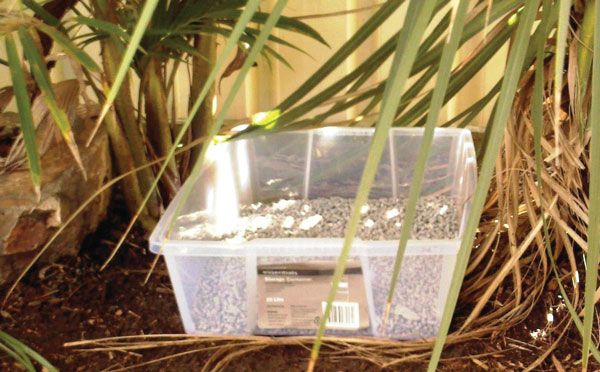
Figure 7.
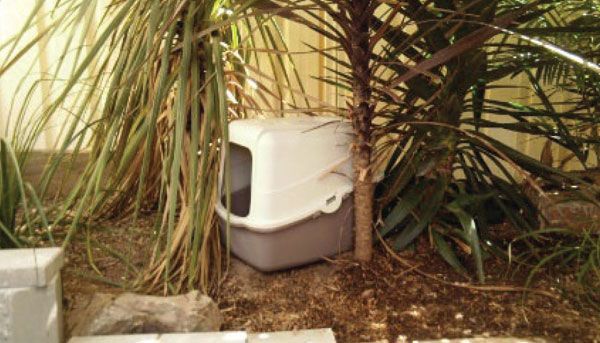
Figure 8.
I have long believed we need someone to design a proper litter box specifically for male cats. Such a litter tray would have a deep tray with high front and back walls and a removable roof option.
Tall Siamese males, or cats who don’t squat down well or for long enough, end up having their urine overshoot the catcher tray. The cats then deal with urine spill by flipping litter from the tray out onto the urine and the floor.
I decided to make my own deep-walled indoor litter tray which my male cats could turn around in and arch up in. I also decided to make it tall enough to keep the urine in the tray. I didn’t achieve a roofed version but this blue toy box version worked well and cost about €10 (See Figure 9). The spray hits the tall wall and slides back into the litter. As the cat ages, a small outside step into the box helps an arthritic cat use the deeper boxes. I used a simple cheap washable plastic footstool as the step (see Figure 10).
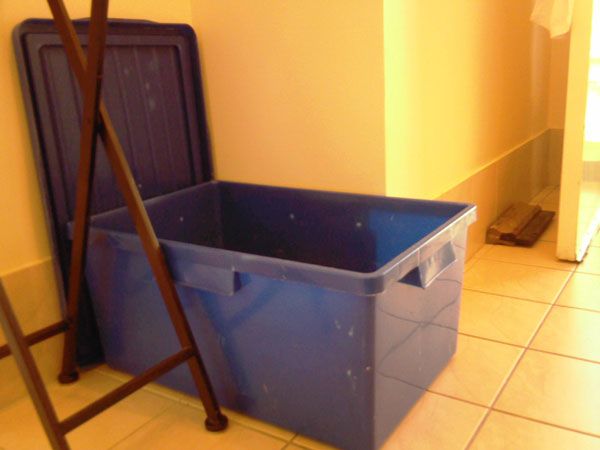
Figure 9.
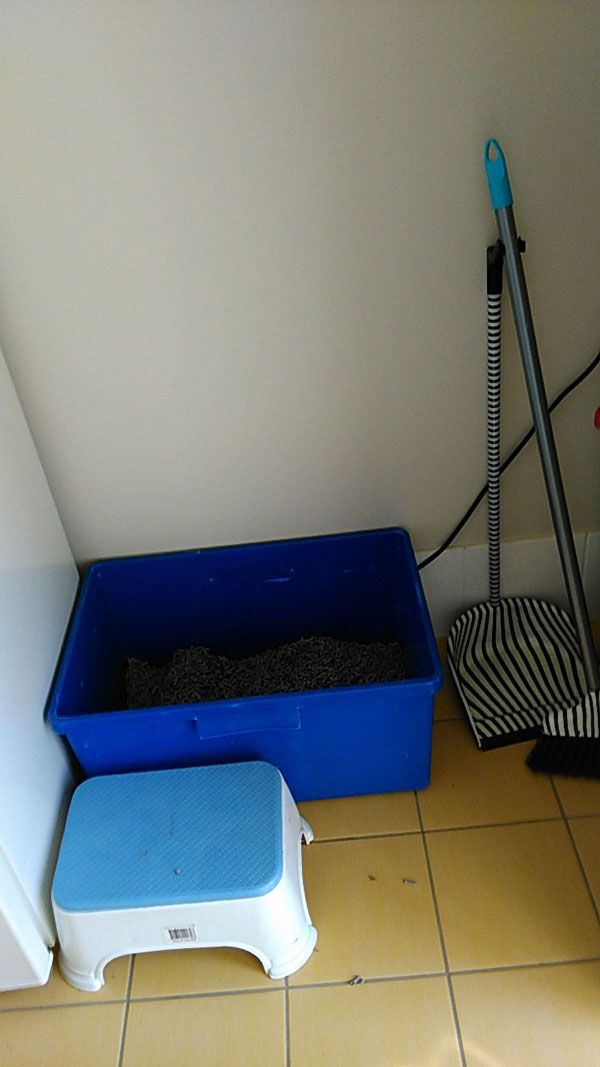
With advanced age, >16years, we found turning the box on its side inside a long, low under-bed trolley box allows elderly cats to step in from walking level and stand tall inside, as the old toy box now turned on its side acts as a wall to catch the high spray of the urination (Figure 11).
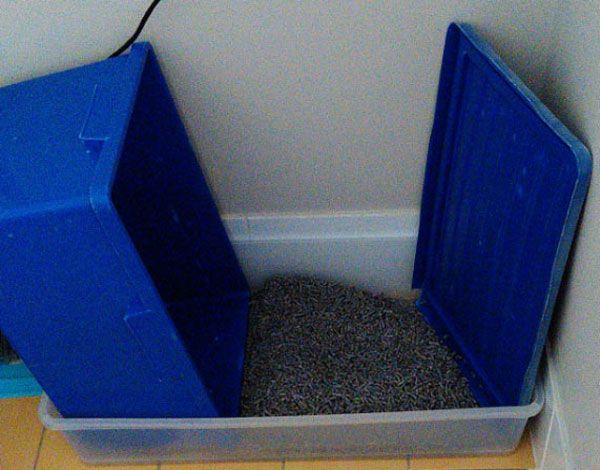
Figure 11.
I found cutting an entry door at different points along a selection of these cheap plastic storage boxes will allow cats in multiple households to select which style of box suits them (Figures 12 and 13).
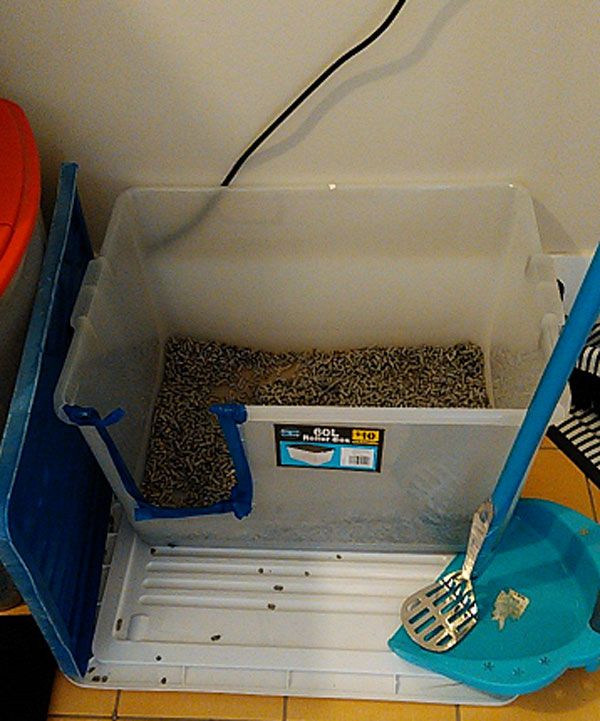
Figure 12.
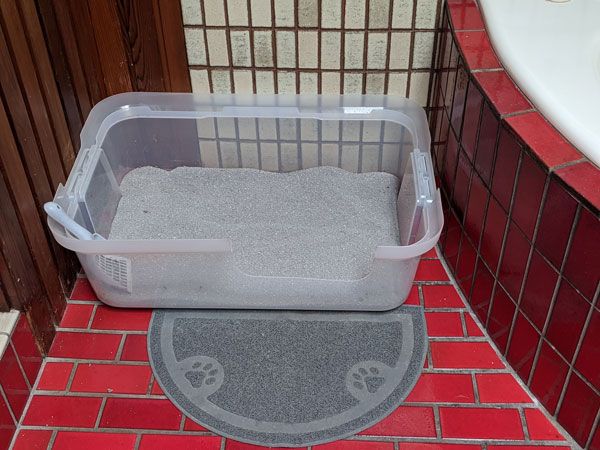
Figure 13.
By sitting a small mat or catch tray at the exit point, all the litter on the cat’s feet stays in a very confined area so there is less mess in general.
All of the storage boxes come with a removable lid so you can cover a tray over if a particular cat prefers that. The lid can also be used to seal over any litter box in areas where small children, dogs or guests are visiting.
c) Position
We were once told to use the laundry area as a tray location but many cats don’t like washing machine vibrations. While cats do love the tumble dryer being on, the combination of damp warm heat and a nearby soiled cat litter box doesn’t work for me. I tended to put my cats’ litter trays in the toilet room, or end of a hallway, in the garage, and in the garden.
For the nervous cat in a multi-cat household who commences using the bed as a toilet area, being able to give that cat access to a tray placed up high, (secured safely) on a shelf with only one entry point to the tray often stops that particular behaviour.
Cats urinate on beds because of the vantage point and safety the bed provides to the anxious pet. The bed is elevated and usually backed up against a wall which means it acts as a high vantage point for the cat to view any unwanted intruders or detect potential ambushes from other pets that might normally lie in wait outside a covered box ready to pounce when the anxious victim exits the box.
The cat can’t be ambushed from behind on the bed; they can back up to the wall, and still have a panoramic guarding view of the bedroom.
Often placing a wide, flat, open litter tray up on the corner of the garage bench (so ambush risk is neutralised on two sides) or on top of a solid bench or shelf in a bathroom or unused wardrobe provides a great alternative option for any physically healthy, but anxious, cat. Another option is to tuck the tray into a corner recess at the back of the bathroom near the bath; this way there are high, cleanable walls on both sides and also the cat is less likely to be ambushed by another cat (see Figure 13).
For elderly or arthritic cats, placing both a bed and a litter tray inside the shower recess can reduce periuria/perichezia accidents and make cleaning up easy. Food and water can be placed just outside the recess, on either side of the door, so the old cat doesn’t have to struggle to perform basic functions.
Litter trays – key points
- Stop thinking about the litter tray just as a receptacle to collect bodily fluids and think of the litter tray as a source of potential environmental enrichment to allow the cat to express normal and healthy scratching, sniffing, and toileting behaviours.
- Match the size of the litter tray or box to the size, age, and health of the cat.
- Think three-dimensionally for cats – consider placing boxes at different heights and in different spaces.
- Provide two different types of litter substrates of different textures and observe which one your pet prefers.
- Assist elderly or disabled owners in taking care of their cats independently and for longer. These owners can struggle to keep litter trays clean. A cheap workaround to scoop out a soiled tray is to tape a right-angled stainless steel potato masher onto the end of an adjustable-length broom handle. This is, in effect, a long-handled pooper scooper small enough to fit into cat trays and scoop out soiled material without the owner needing to bend to clean the tray. The metal end can be cleaned under a running tap etc.
1. Which of the below can be helpful to educate a client to assess their pet’s quality of life?
A. Veterinary staff to have a pre-euthanasia consultation to offer the client guidance to appropriate resources
B. Have an in-clinic, pre-printed quality of life questionnaire for client to use
C. Offer the client the link to Ohio University’s ‘Honoring the bond’ information sheet
D. All of the above
2. Wrapping a freshly deceased body creates:
A. A more ergonomic way for veterinary staff to move the body
B. Creates less visual disturbance for everyone
C. Presents the body in a more ideal presentation for the crematorium
D. All of the above
3. Which of the below medical disease presentations can trigger cats to urinate outside the litter box?
A. Diabetes
B. Urinary tract calculi
C. Infection
D. Osteoarthritis
E. Cognitive decline
F. All of the above
4. Which statements below are correct?
A. Cat litter trays should be at least 1.5 times the length of the cat
B. The number of litter trays should exceed the number of cats by one
C. All litter trays must have a covered roof
5. Which suggestions below are correct?
A. Match the size of the litter tray or box to the size, age, and health of the cat
B. Think three-dimensionally for cats – consider placing boxes at different heights and in different spaces
C. Ensure the exact same type of litter is used in all the cat litter trays
ANSWERS: 1D; 2D; 3F; 4A and B; 5A and B.
















